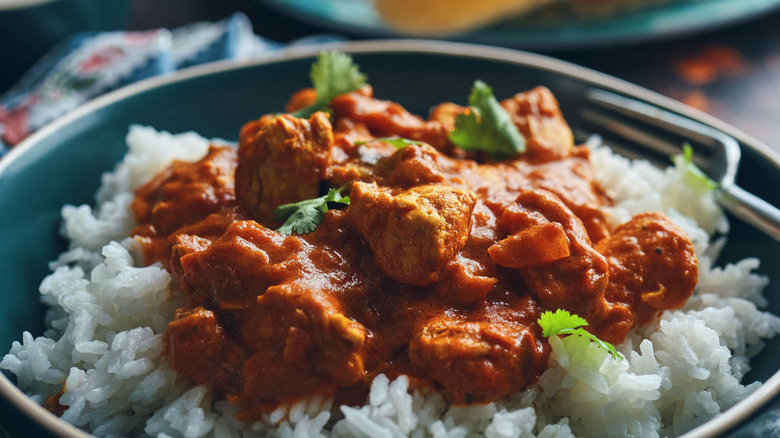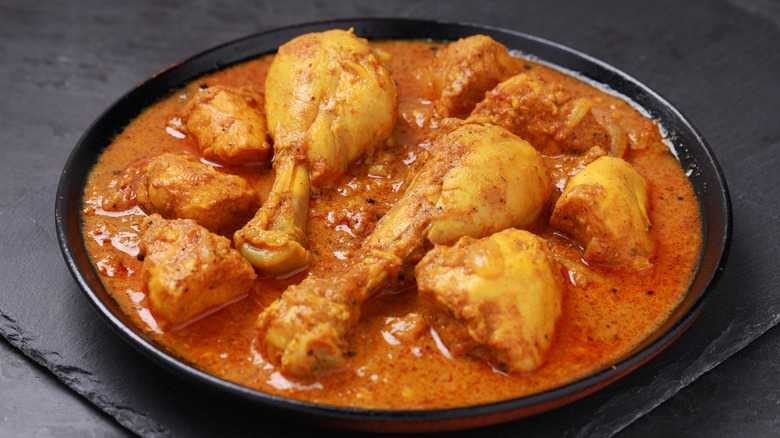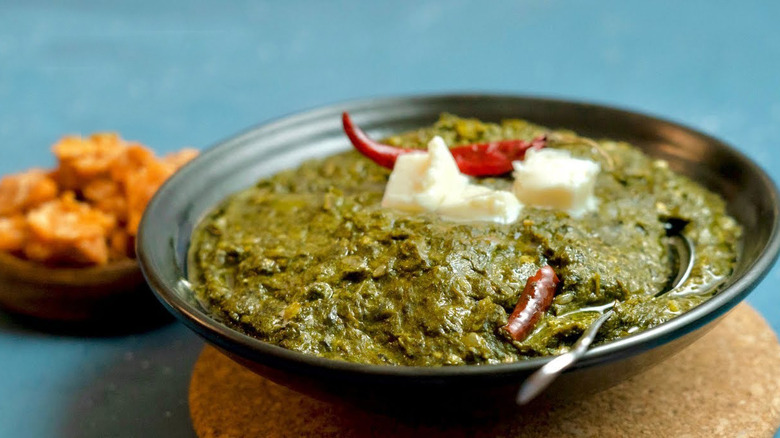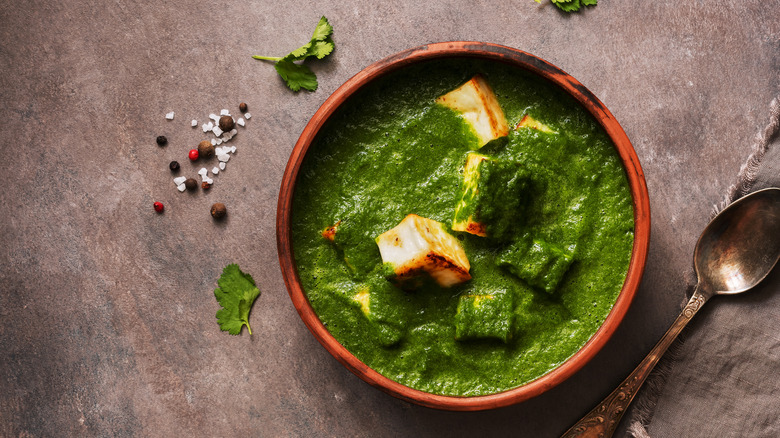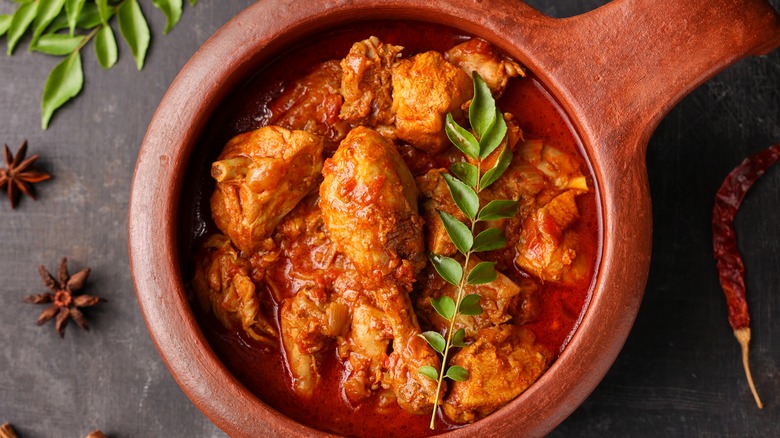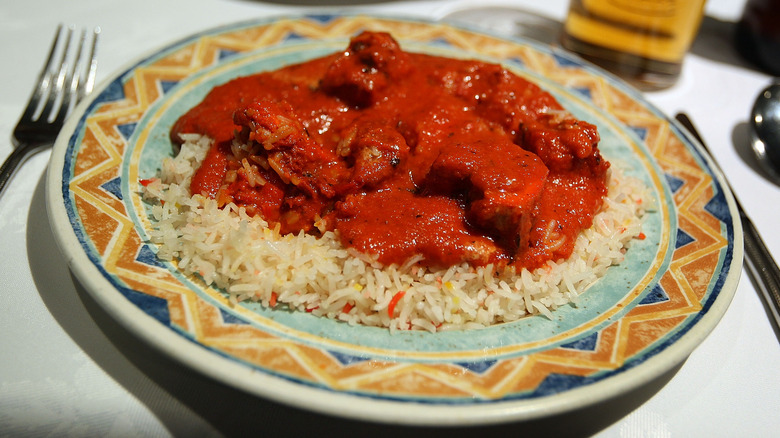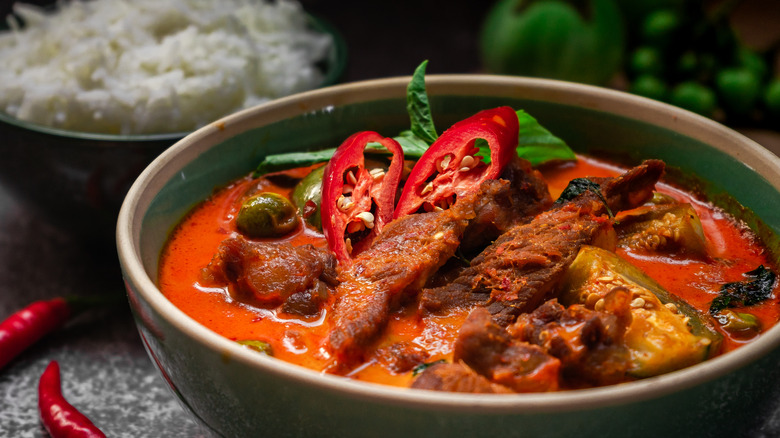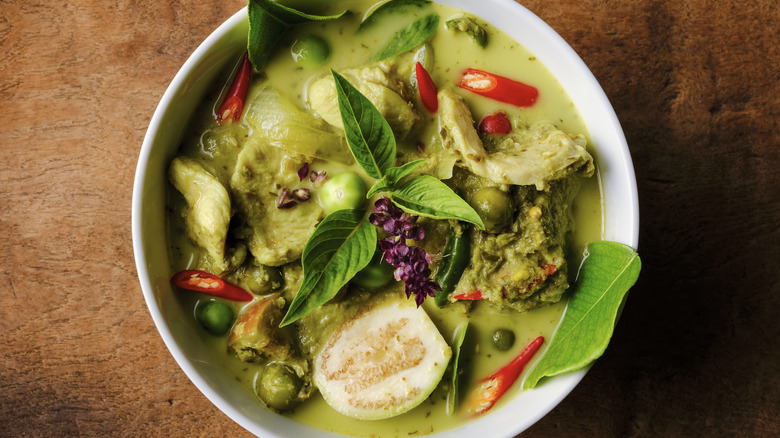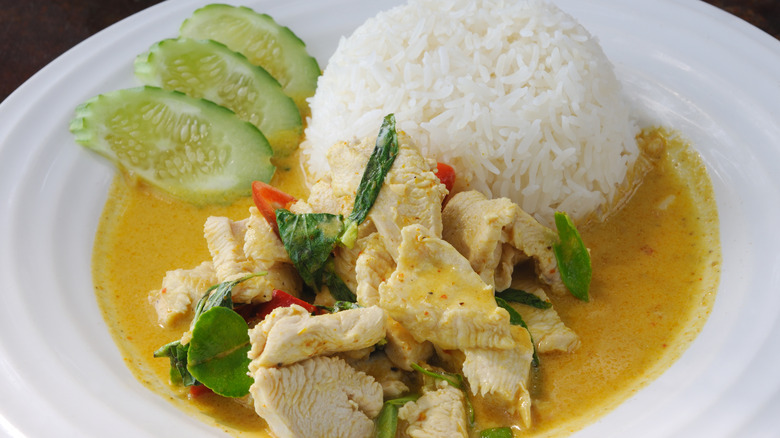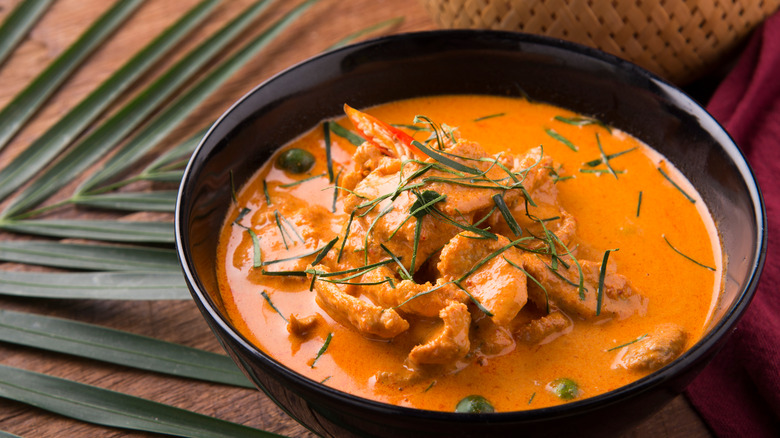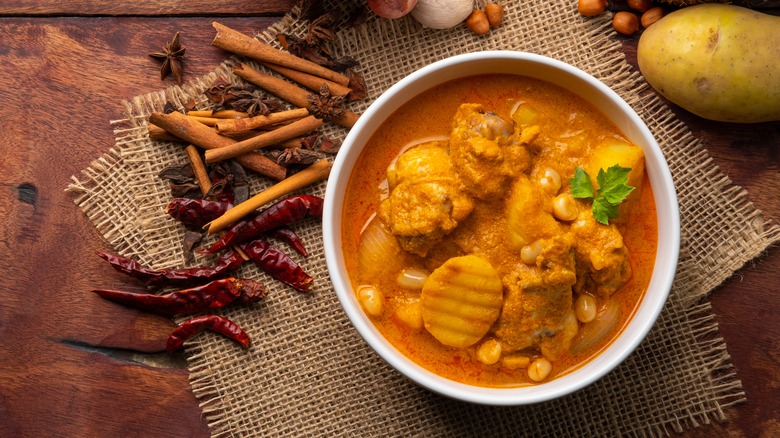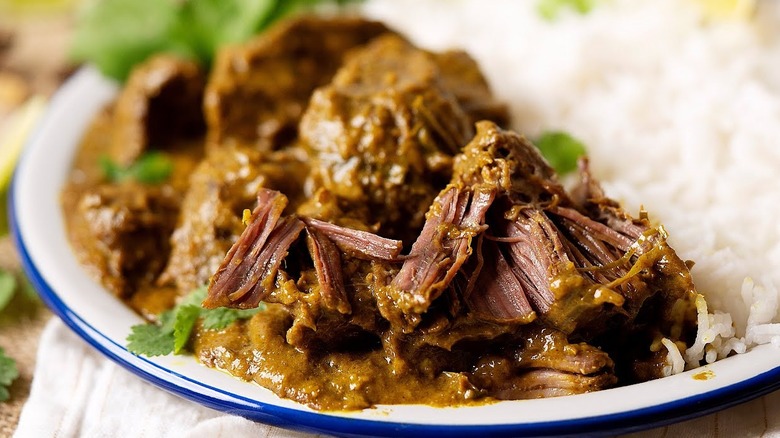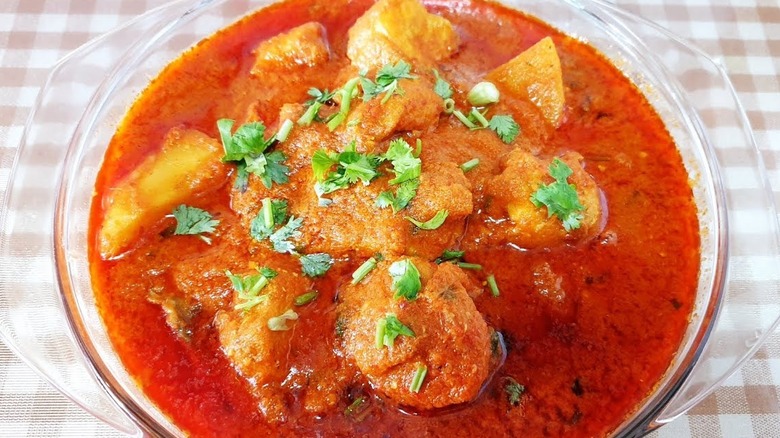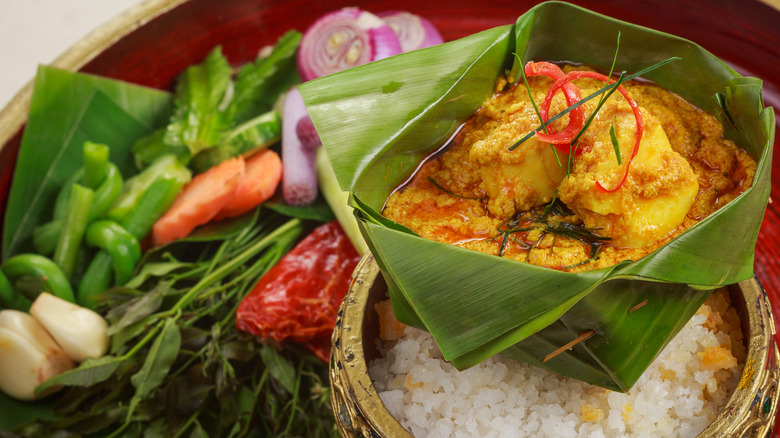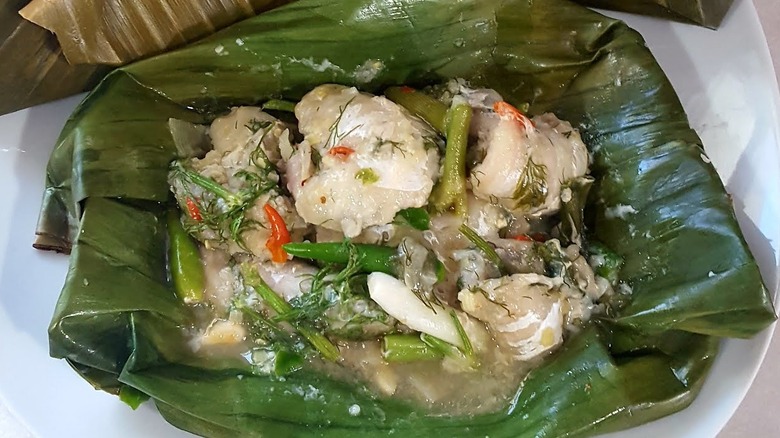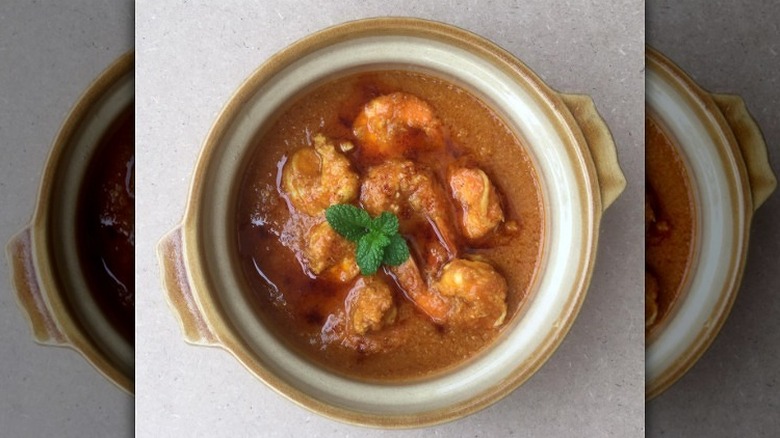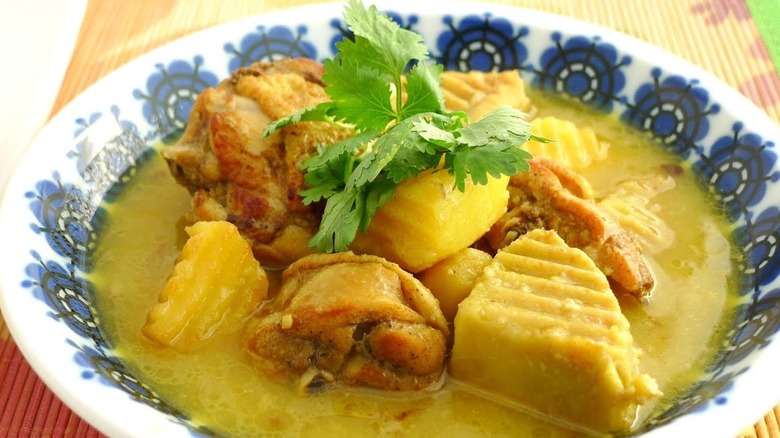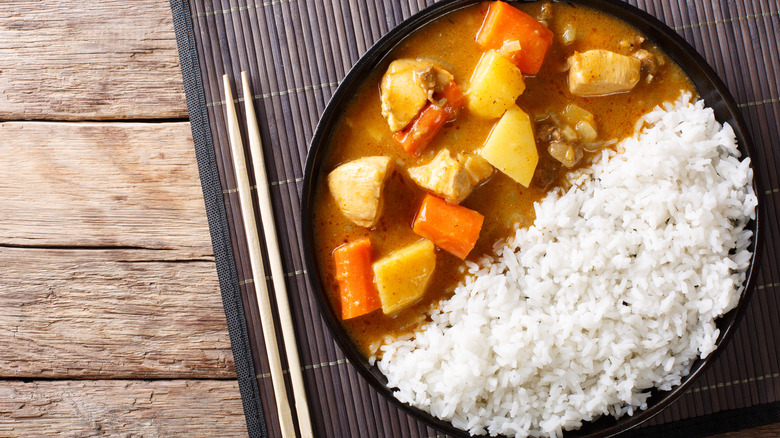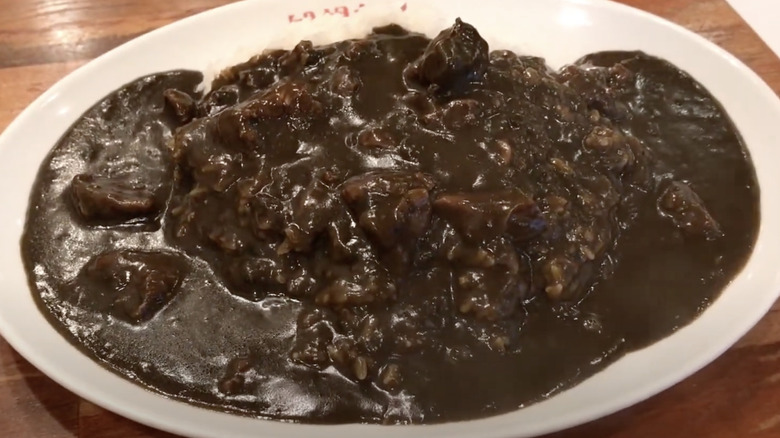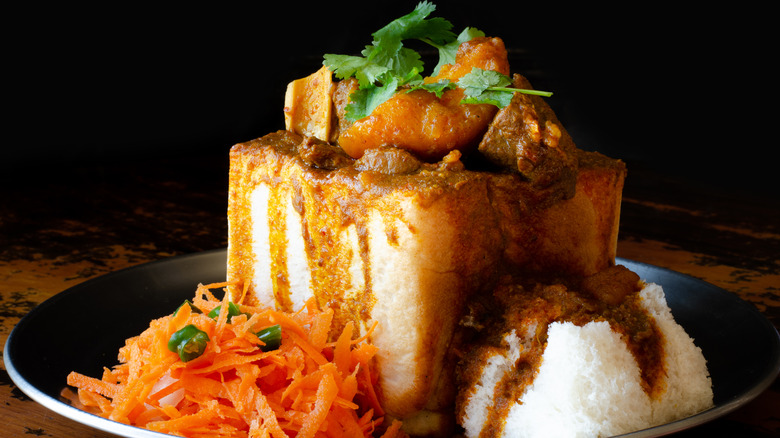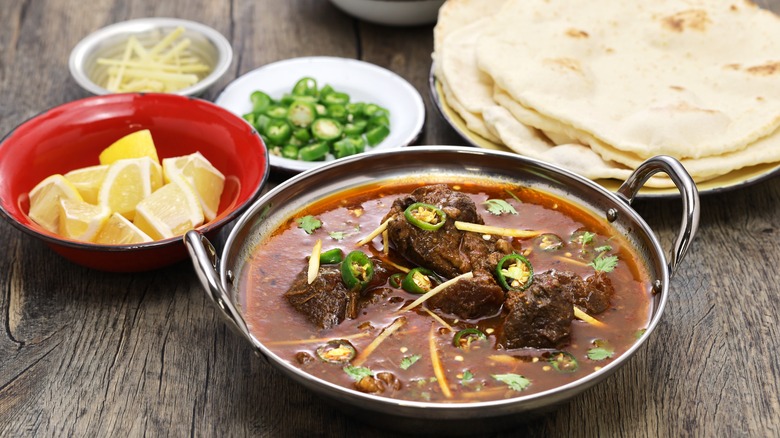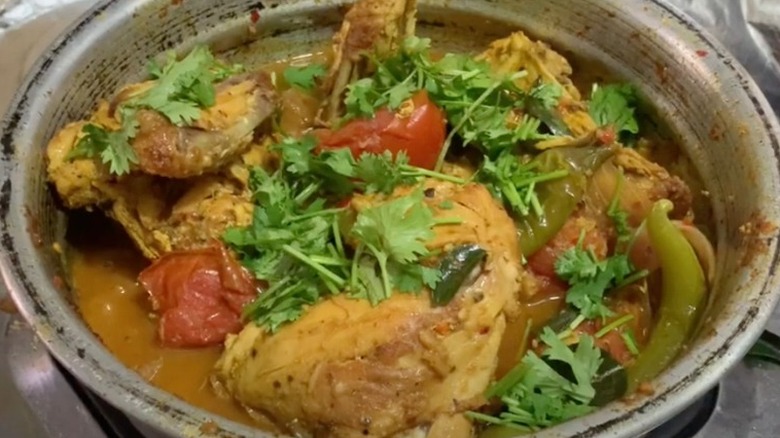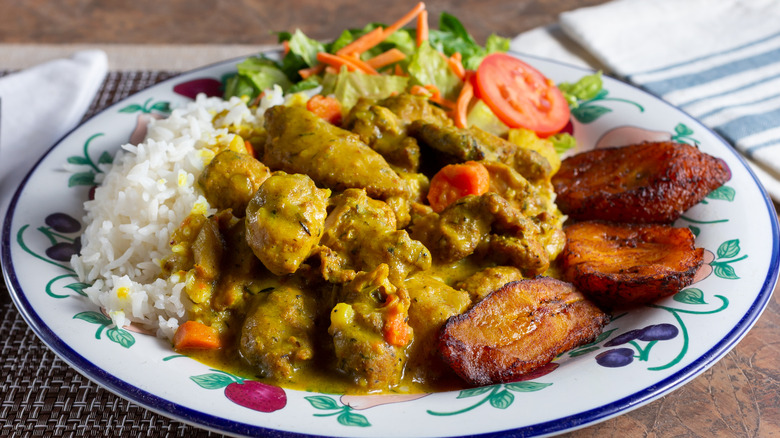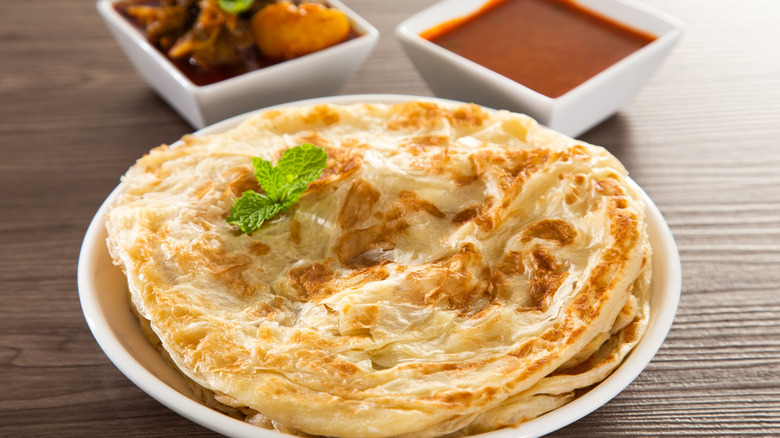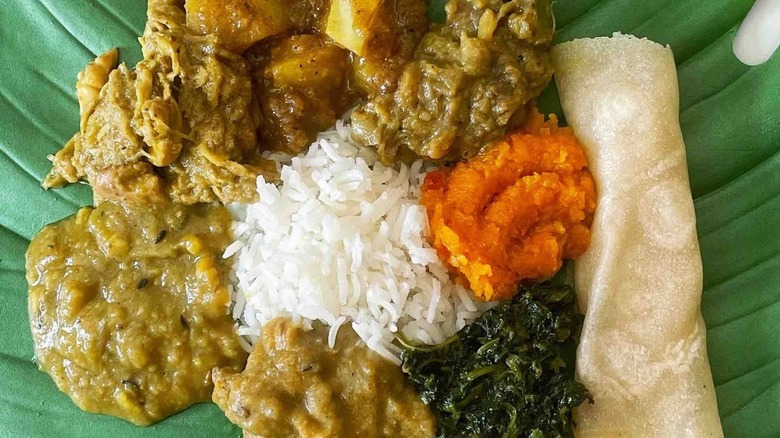25 Types Of Curry, Explained
Creamy, savory, aromatic, and simply mouthwatering, curry is one of the world's most beloved sauces. According to Britannica, it's believed that curry originated in India. Years of European colonialism had the unintended effect of helping it become an international staple. Contrary to popular belief, curry isn't actually an Indian word and represents many types of dishes. The word itself is a possible derivative of kari, which comes from India's Tamil language and means "sauce." It's believed that British attempts at pronouncing the word resulted in curry.
Britain and beyond, the spice's alluring aromatics have cast a global spell, spreading and evolving over the years. Today, an almost endless variety of curries exist. From the shrimp paste-infused umami of Thai curries to lesser-known fiery Middle Eastern types, the appeal of curry is boundless. It's even made its way up to Germany. Raise your hand if you're a currywurst fan!
Due to curry's expansive reach, it'll take a literal lifetime to taste every kind. Some types are still only available regionally, carrying nuances foreign tongues have yet to experience. Whether your nickname is Captain Curry or you're a person with a picky palate, we believe there's a style for you. To introduce the curry-curious, and to further inspire adventurous eaters, below is a list of popular types from around the world. The list in no way encompasses every curry, but it's a great kickstart.
Korma
In the motherland of curry, there are many popular styles to choose from. One is called korma, or qorma, which originates from the Mughal cuisine of India's subcontinent. It's traditionally made using braised meats or vegetables in yogurt or cream, stock, and a blend of spices that form to create a saucy rice topper and necessary naan dipper.
Korma is the perfect cozy sauce for chilly temperatures and can be customized to complement the protein or veggie of your choice. You can even elevate the texture by adding nut butter to your korma sauce. As one of the more popular curry styles, korma is widely available at grocery stores in pre-packaged forms and at most Indian restaurants. If you fancy yourself more hands-on, try out this crave-worthy vegetable korma recipe.
Saag
Another popular curry style is saag. It hails from India's Punjab region and blends mustard leaves and spices. The characteristic green color commonly comes topped with a slice of fresh butter or ghee and enjoyed with rice, roti, or naan bread. Like korma, saag is a globally beloved curry flavor and can be found on most Indian restaurant menus.
Along with mustard greens, saag is mixed with spinach, which helps balance the bitter taste. Once cooked and mashed into a paste, the leafy combo is slow-cooked with ghee, onions, ginger garlic paste, and corn flour. If you haven't experienced this tasty curry, we definitely saag-gest you give it a try.
Palak paneer
One delicious Indian dish you have to try at least once is palak paneer. The curry is similar — and often mistaken — for saag, except it is made using spinach, fresh-pressed cheese, and spices. While both are green, saag is typically creamier, and the yogurt base of palak gives it more of a tang.
Also hailing from India's Punjab region, the savory touch was made to perfectly pair with basmati rice, naan bread, or both combined. From spoon to tummy, this traditional curry is sure to add some flavor to your life. The best part is that the recipe for palak paneer is simple and only takes a little over half an hour.
Vindaloo
Rounding out some of India's most popular curries, locally and globally, is vindaloo. Piquant, velvety, and rich vindaloo's robust flavor will certainly put your tongue to the test. According to the South China Morning Post, this special curry actually originates in Goa via Portuguese colonizers.
Per reporting, the locals were inspired by a dish called 'carne de vinho e alhos.' Apparently, the Goan attempt at pronouncing the Portuguese "vinho e albos" sounded more like "vindaloo." It was created by substituting several ingredients — wine in place of vinegar, chicken rather than pork, and red Kashmiri chilies and spices. Like other curries, vindaloo pairs well with your protein preference, and potatoes are popular too. Fresh peppers, in particular, will take chicken vindaloo to the next level.
Tikka masala
England's most popular curry is believed by some to have actually been invented in ... surprisingly, England. While tikka masala's true origins are mysterious, there's no mystery that it's undeniably tasty. In fact, according to Britannica, it's considered Britain's national dish.
Masala's creamy and spicy sauce is most commonly simmered with chunks of char-grilled chicken and served over rice. Packing a full-bodied punch, its smokey accented flavors consist of garam masala, red chili powder, cumin, turmeric, coriander, and salt. That aromatic array is then blended with yogurt to form the masala sauce. Britain's national dish is also a popular go-to in America — one could say the apple doesn't fall far from the crumpet.
Thai red curry
Thailand is known for several popular curries; one piquant variety is the aptly-named red curry. The curry paste is made using lemongrass, ginger, garlic, galangal, shallots, coriander root, and an aromatic mixture of spices like cardamom, nutmeg, cloves, coriander, cumin, and cinnamon. The reddish color comes from loads of chili peppers, which gives it a standout bang.
Unlike Indian varieties that use yogurt, Thai red curry is typically blended with coconut milk to give it a broth-like consistency that goes great with your choice of protein, potatoes, vegetables, and even peanuts. Take it from us; you should add this Thai red curry chicken recipe to your "Must Try" list immediately!
Thai green curry
A milder and subtly sweeter twin to red curry, Thai green curry carries just the right level of spiciness for people who like a little punch but can't take a big kick. Made using much of the same ingredients as the red kind, it gets its distinctive color from fresh green bird's eye chilies, which have a fruity and intensely peppery profile — green Thai chili peppers also work as a substitute.
Coconut cream adds an accent of sweetness to the sauce, rounding out the complementary ingredients. Also, like red, Thai green curry is usually served with tofu, various proteins, and veggies in a bowl with a side of rice or noodles. If you're looking for a quick and savory meal, look no further than Thai green curry paste, it only takes 10 minutes to prep.
Thai yellow curry
Rounding out Thailand's trifecta of color-specific curries is yellow curry. Although it shares many of the same ingredients, yellow curry is milder than its red and green siblings. Usually, the creamiest curry of the trio, the addition of turmeric root (or powder) gives a distinctive yellow shade. Its full-bodied flavor also has a touch of sweetness from coconut milk and sometimes the addition of sugar.
Chicken or beef are great canvases for yellow curry's savory paint. Other go-to ingredients are carrots, onions, and potatoes — starchy veggies are excellent too. As one of the more popular Thai curries, it's widely available at Thai restaurants around the world.
Panang curry
After you've toured through Thailand's red, green, and yellow curries, you should definitely hit a sharp left at panang curry Avenue. Not to be confused with red curry, panang has a similar vibrancy but incorporates different ingredients like peanuts and sometimes even basil leaves. It's an extremely versatile dish that lends itself to a little tweaking here and there.
In fact, you're likely to experience varying versions of it from restaurant to restaurant. Sweeter and creamier than the other Thai curries, panang's panache is balanced by citrusy kaffir lime leaves. It's widely available at most, if not all, Thai restaurants.
Massaman curry
One of the more complex curries coming out of Thailand is Massaman. More commonly associated with the country's Muslim community, the stacked ingredient list of Massaman is actually inspired by Indian curries, which typically use more than Thai varieties. Yellow or orange in color and milder in taste, rather than the spicy kick of chili peppers, massaman is fragrant, sweet, and softer on the palate.
That makes it an excellent curry coat for chicken, beef, lamb, mutton, or goat. Like panang, roasted peanuts are popular garnishes. Although this massaman curry recipe takes a tad longer than other curries, its savory spell is worth falling under.
Rendang curry
You'll find yourself greeted by another unique realm of curry upon arriving in Indonesia. Originating from West Sumatra, Rendang curry is the country's most popular kind. It's addictive, deeply aromatic, and has a dryer consistency, unlike the soupy style of Thai curries. You'll most often find it paired with beef, but it goes great with chicken, duck, and more.
The culture surrounding this special dish involves not only ensuring deliciousness but there's also a purposeful philosophy as well. According to the Journal of Ethnic Foods, to the people of Indonesia, the long cooking time associated with rendang is connected to practicing patience, wisdom, and sincerity.
Devil curry
This next curry might just test your faith. The piquant name alone will either pique your interest or make you take a peek for the nearest exit. Devil curry originates from Malaysia and contains the country's own unique blend of ingredients like vinegar, tomato paste, and Dijon mustard ... Along with mustard, black pepper, and loads of red and green chilis are combined to bring some serious heat.
Devil curry's spicy tang tastes awesome on chopped chicken, rice, bread, and more. In Malaysia, it is traditionally served as a dish on Christmas with leftovers. That gives you an opportunity to throw a culinary curveball next holiday season.
Amok curry
Considered to be Cambodia's national dish, amok trei, or steamed curried fish, is an excursion into the country's culinary history. While the origins of the introduction of curry to the country are debated, one thing's for sure, Cambodia really put its own spin on the dish. And traditional amok curry takes time and patience.
It involves creating a spice paste called kroeung, which is a general term for select spice blends used in the country's regional dishes. It's basically Cambodia's version of curry paste. Along with kroeung, marinated white fish is typically blended with eggs to give it a soufflé texture, then wrapped in a beautiful banana leaf bowl. We'd say it's definitely worth running for.
Mok pa curry
Joining Southeast Asia's curry collective is Laos, and one of the country's most popular traditional dishes: mok pa. Otherwise known as Lao steamed fish, the origins of this special curry are scant and otherwise murky, but one could compare it to Cambodia's amok curry. Both are fish-based dishes that are wrapped and served in banana leaves. Unlike their Cambodian neighbors, Laotians don't use coconut milk.
The flavor profile is further differentiated with the addition of padek (a local fish sauce), dill, and basil. Next, the fish is cooked until it's juicy, tender, and perfect for dolloping over sticky rice. It can be enjoyed non-spicy or with an extra kick.
Pazun hin curry
The next curry comes from the country of Myanmar (Burma) in the northernmost part of Southeast Asia. Carrying influences from surrounding countries India, China, and Thailand, Burmese curry is similarly versatile yet incorporates dry spices and fresh herbs, making it one of the mildest Southeast Asian varieties.
Mildness aside, it's an oily curry-style that's cooked until the oil separates and rises to the top, ensuring the spices blend thoroughly. A popular Burmese curry dish is pazun hin, otherwise known as shrimp or prawn curry. Locals enjoy it because it's not only super tasty, but it's a quick and easy recipe perfect for leftovers. Fun fact, its high oil content actually helps extend its edibility by protecting it from bacterial contamination.
Cà ri gà
For our purposes, Vietnam rounds out Southeast Asia's distinctive curry styles. Curry as a dish was introduced to the country by Indian migrants. Infusing the local cuisine would inspire the creation of Vietnam's very own curry dishes. One popular comfort staple is cà ri gà — cà ri meaning curry, and gà standing for chicken.
Cà ri gà is a yellow-colored curry made with lemongrass, chopped onions, potato and sweet potato, and chicken. It's blended with coconut milk and, interestingly enough, thanks to French colonization, is traditionally served with a baguette. If you're into sweet curries, a fun substitute for potatoes is the earthy-sweet taro root, a similarly starchy root vegetable.
Japanese kare raisu
In its travels around the globe, curry was also introduced to Japan. Historically, British and Indian influence infiltrated the country during the Meiji period, which lasted from 1868 to 1912. Simply referred to as Japanese curry or kare raisu (curry rice), it has a gravy-like consistency that's thick and filling.
The thickness of kare raisu comes from a roux that's mixed with curry spices. Due to its popularity, it's widely available at grocery stores in premade forms, which makes it an easy and affordable meal option. If you prefer a fresher experience, you can also make it from scratch and enjoy it with vegetables and your choice of meats.
Kuro curry
A lesser-known curry from Japan that packs an explosive amount of umami might turn you away at first sight. Black curry, also known as kuro curry, subverts everything we've come to expect of the savory sauce. Mainstay ingredients like turmeric and chilis are replaced with unique ones like norikuro (black seaweed paste), or squid ink, and sometimes even chocolate — that's where it gets its distinctive midnight color.
Kuro curry is most popular in Japan's Northwestern region, though unfortunately, you'll be hard-pressed to find many restaurants that offer the silken, buttery, and dark mix outside of the Land of the Rising Sun.
Bunny chow
The ways in which food has traveled the world and cuisines have evolved over time aren't always the prettiest parts of history. That's definitely true of South African curry, which is a story of survival for Indian migrants who settled in what became Durban. Let's cut to the curry, though; Durban-style is a pungent and peppery red-colored sauce.
Unlike traditional Indian and Asian curries, no coconut milk or creams are used. A popular Durban curry dish is called bunny chow. It involves hollowing out a loaf of bread and filling it with curry. If you don't mind a trip to Scoville, we definitely think bunny chow is a must-try South African dish.
Nihari curry
Unsurprisingly, curry found a home in the fiery temperatures of the Middle East as well. One traditional Pakistani dish, in particular, is known as a type called nihari curry, which is a customary dish everyone should try at least once. According to The Times of India, the word itself is derived from the Arabic root word nahaar, or "day," and fittingly describes when it's most commonly consumed.
Traditionally slow-cooked overnight with beef shanks; nihari curry is a complex recipe that can include up to 50 ingredients. Even today, as master time-savers, the quickest nihari recipe you'll find will still require over three hours of your time. Fortunately, it's a pretty common menu item at most Middle Eastern restaurants.
Quwarmah al dajaj
There's something heavenly about the pairing of curry and chicken. It seems that no matter where curry has traveled, chicken is a universally beloved complement. In Kuwaiti cuisine, the take on it is called quwarmah al dajaj, or simply Kuwaiti curried chicken. The country's special Arabic-style blend of lime, ginger and turmeric, baharat, cumin, cardamom, black pepper, cinnamon, nutmeg, and paprika creates a curry uniquely Middle Eastern.
Quwarmah al dajaj is equal parts sour, savory, warming, and spicy. Kuwaiti curry tastes robust and aromatic, carrying a saucier (rather than creamy) consistency since coconut milk and yogurt aren't used. While lesser known, there's a chance you may find this special curry style at Middle Eastern restaurants.
Curry goat
We hate to admit it, but if it weren't for British colonialism, there's no telling how or if curry might have found its way to the small island of Jamaica. Today, curry is one of the country's most popular spices and is served with every meat available. Curry goat is an especially popular Jamaican dish you should order when you see it.
The goat is slow-cooked in a yellow-colored curry until tender and aromatic. Curried proteins are usually accompanied by rice, stewed cabbage or greens, plantains, and sweet Jamaican coco bread. This Caribbean-style curry is sold at all Jamaican restaurants and in ready-made form at grocery stores.
Tridadian roti
One place Indian culture left an indelible mark in Trinidad and Tobago. So much so that, according to the United Nations, today much of the population is made up of Indians, and many Trinidadians practice Hinduism. You can imagine the influence they had on the local cuisine. Curry powder there is less spicy and popularly enjoyed with roti and doubles, which are staple street foods.
Roti is fried flat bread you use to scoop up the curry like a taco, while doubles are pillowy fried flat bread served with curry in a sandwich style. Along with roti and doubles, Trinidadian-style curry is served with meat, seafood, and vegetables.
Seven curry
Not only does this unique curry from Guyana has a cool name, but it also offers more variety in a single dish than all others on this list. That's because it's not just named seven curry; it's a dish that's actually composed of seven different vegetarian curries. Intended to be hand eaten, seven curry includes pumpkin, bagee (spinach), catahar, potato/channa (chickpeas), balange (eggplant), eddoe (which is closely related to taro), and dal.
It's normal for locals to substitute certain ingredients in their seven curry for similar foods too. It's traditionally served on a large water-lily leaf and topped with mango/tamarind achar (pickle) and pepper sauce. With seven curry flavors to enjoy, you're bound to find a new fav.
